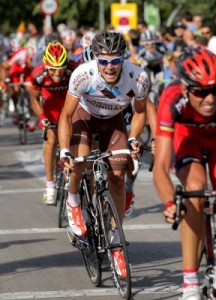“Just bought my first pair of cycling shoes and clip-in pedals and, after all I have heard about how efficient they make your pedaling, I would have to say I was disappointed. Are the benefits from cycling shoes and pedals to small to notice? Or do they take some time to get used to?” –Andy
First, as we all know, you really do ‘clip into’ clipless pedals. And we all have our embarrassing “Oh Crap, slow motion tip-over” when we first start using them. I think it is a required rite of passage.
Efficiency boils down to energy transfer from your legs to the pedal, and there are several variables that impact this, including our mechanics of the pedal stroke and to some extent the cycling shoe. Cadence and bike fit affect your efficiency as well, but we won’t talk about those today.
The shoe.
The biggest benefit to using a cycling shoe instead of a sneaker is the stiffness of the sole. If you are riding with flat pedals and sneakers, when you push down, your shoe bends a little. That’s energy going from your leg to the shoe rather than your leg to the pedal stroke.
We want as much energy going from our leg to move the pedal. Any energy lost in between is a loss of efficiency. The stiff sole of a cycling shoe doesn’t bend, and hence allows for better energy transfer to the pedal stroke.
The Pedal Stroke.
The stroke is essentially a circle. Your foot goes around, although force distribution isn’t even across the entire circle.
When you have a flat pedal, you can start applying pressure just slightly past the 12 o’clock. Once your foot gets to the bottom of the stroke, actually at about 5 o’clock, your effectiveness at applying force is greatly reduced.
From 6 back to 12 o’clock the pedal is moving upwards, and so while our foot might maintain contact with the pedal, there is nothing we can do to help the pedal move up. If we lift our foot, it would come off the pedal. So our stroke turns into a “push down, relax, push down, relax.” While it might feel smooth, in reality the energy transfer isn’t.
Now let’s get “clipped in” to our pedal. Because we now have full contact with the pedal during the entire stroke, we can help the pedal up. Now I’m not advocating lifting strongly, as you still want to relax during that part of the stroke. I explain how I think about pedal strokes here in a minute. But being able to pedal “on both sides” of the stroke allows for a much smoother stroke and more consistent transfer of energy. If you ride hills a lot, the ability to “pull up” on the pedal when clipped in to smooth out the stroke is also a huge benefit to keep from “mashing” up the hill.
Even if you are riding with cages/toe clips, unless you strap your foot in really tight (which may not be the safest because it will be hard to get your foot out in case of emergency), you can’t pull back much on the pedal stroke. But you can pull up a bit.

Simply switching over to clipless pedals isn’t the only answer to improved efficiency because you need to make sure you train your muscles to have an efficient stroke. One of the best ways to do this is to practice single leg drills. These are most safely done on a trainer. Unclip one foot and rest it on the trainer behind you. Make sure you are in an easy to moderate gear and then pedal for about 30s with the clipped in leg.
If you are new to this, you may notice a ‘clunk’ and dead spot as you come over the top of the stroke. You don’t want this – you are essentially losing contact and losing energy. Work to get the stroke as smooth as possible, no clunk or dead spot. The whirr of the wheel on the trainer should be consistent. Switch legs and see how the other leg does. Don’t be surprised if you have one leg that does better than the other.
To smooth out your stroke, think about pushing the pedal straight over the top from 11-1 o’clock and then pulling straight back from 5-7 o’clock. Chances are you will have to think about an early initiation of this, meaning if you wait for your foot to be at 5 before pulling back, it will already be past.
See below for a drill session you can use on an easy day or during your base phase or off season to improve pedaling efficiency. You can also just add in a few sets of single leg drills to the end of another workout.
While right after switching to clipless pedals, you may not feel a difference, I guarantee if you were to compare a ride of about 2 hours or more just on flats or in cages using sneakers with the same ride in road shoes and clipless pedals, your legs will be less fatigued at the end of the ride with clipless pedals.
For more detail on pedaling biomechanics, here is a good summary article.
Single Leg Drill Session
Warm up: 10 minutes easy spin
Drill set (go through twice):
2 min at 85-90 rpm (RPE* 4-5)
8x30s single leg pedal (moderate gear, ~70rpm, do each leg 4 times alternating legs, allow ~5s to switch legs)
1 min easy spin (95+ rpm, RPE 2-3)
8x30s single leg pedal (big gear, ~50-60rpm, do each leg 4 times alternating legs, allow ~5s to switch legs)
2 min easy spin (95+ rpm, RPE 2-3)
Cool down: At least 5 minutes of easy spinning
*RPE=Rate of Perceived Exertion on a 1-10 scale.
Have a question for Coach Nicole? Ask it here.





